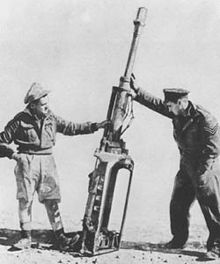MK 101
The M achines k anone MK 101 was a cannon in mm caliber 30 , of the German company Rheinmetall-Borsig was developed and German fighter planes was used during the Second World War. Although it was precise, powerful and had a high muzzle velocity , it was also very heavy and had a low rate of fire so that it was only produced in small numbers.
development
The MK 101 was originally developed in 1935 by the Rheinmetall-Borsig company under the name MG-101 as a long- barreled automatic cannon that was capable of carrying nine different types of 30 × 184 mm B ammunition (e.g. high-explosive or armor-piercing ammunition Tungsten core). It was developed from the MK S18 / 1000 anti-tank rifle . It had a pneumatic cocking lever , fired with the help of an electromagnetic percussion lock and was recoil operated. For the time, the weapon was extremely accurate and achieved a high level of penetration (it could penetrate 7.5 cm thick armor at a distance of 300 meters), but was only partially suitable for air combat due to its low rate of fire of 230 to 260 rounds / min .
commitment
From the end of 1941 it was mainly used in the Henschel Hs 129 ground attack aircraft and also in a dozen converted Heinkel He 177 A-1 bombers . Attached to the fuselage of an Hs 129 and equipped with armor-piercing tungsten ammunition, it was able to penetrate the turret and side armor of the heavy Soviet KW-1 tank. An electrically operated version of the MK 101 was developed later and was used as the MK 103 .
See also
Web links
Extensive information and images on the MK 101, including numerous original documents.
Individual evidence
- ^ Antony L. Kay, John R. Smith: German aircraft of the Second World War. Including helicopters and missiles. Naval Institute Press, 2002, ISBN 1-55750-010-X , 9781557500106, p. 169.
